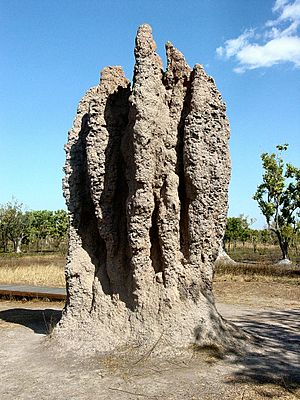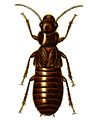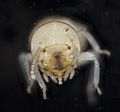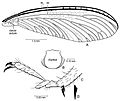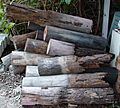Termite facts for kids
Quick facts for kids TermiteTemporal range: Upper Triassic – Recent
|
|
|---|---|
 |
|
| Formosan subterranean termite soldiers (red colored heads) and workers (pale colored heads). | |
| Scientific classification | |
| Kingdom: | |
| Phylum: | |
| Class: | |
| Subclass: | |
| Infraclass: | |
| Superorder: | |
| Order: |
Isoptera
|
Termites are amazing insects that live in big, organized groups. They are called eusocial animals, just like ants, bees, and wasps. This means they work together in a colony, and each termite has a special job.
People sometimes call termites "white ants," but that's not quite right! Termites are actually different from ants. There are about 4,000 different kinds of termites known around the world.
Termites mostly eat dead plants. This includes wood, fallen leaves, soil, or even animal waste. They are very important in nature because they help recycle these materials, especially in warm, tropical places.
How Termite Colonies Start
A termite colony begins when special winged termites, called alates, fly out to find a mate. After they mate, they land on the ground and pull off their wings. The female then looks for a good spot to start a new home, and the male follows her.
Most termites build their homes underground. But in places like Africa and Australia, some termites build huge mounds that can look like small mountains. These mounds can be taller than 20 feet!
Life in a Termite Colony
Termite colonies can be very large. They can have hundreds of termites or even millions! Termites are a great example of how animals can work together. They use "swarm intelligence" to find food and build their homes. This cooperation helps them do things that no single termite could do alone.
A typical termite colony has different types of termites, each with a specific role:
- Nymphs: These are the young termites that are still growing.
- Workers: These termites do most of the work. They find food, build and repair the nest, and care for the young.
- Soldiers: These termites protect the colony from enemies. They often have big heads and strong jaws.
- Reproductives: These include the king and queen. The queen's main job is to lay eggs and grow the colony. There can sometimes be several queens in one colony.
Images for kids
-
The giant northern termite Mastotermes darwiniensis looks a bit like a cockroach, showing how they are related.
-
Crab spider with a captured winged termite.
-
The Rhizanthella gardneri is pollinated by termites.
-
Cathedral mounds in the Northern Territory, Australia.
-
A termite mound in Queensland, Australia.
-
Termites inside a mound in Analamazoatra Reserve, Madagascar.
See also
 In Spanish: Isoptera para niños
In Spanish: Isoptera para niños


